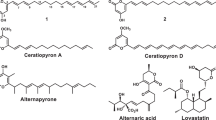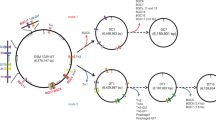Abstract
Lasso peptides are a class of ribosomally biosynthesized and posttranslationally modified peptides with a knot structure as a common motif. Based on a genome search, a new biosynthetic gene cluster of lasso peptide was found in the genome of the proteobacterium Sphingomonas koreensis. Interestingly, the amino acid sequence of the precursor peptide gene includes two cell adhesion motif sequences (KGD and DGR). Heterologous production of the new lasso peptide was performed using the cryptic biosynthetic gene cluster of S. koreensis. As a result, a new lasso peptide named koreensin was produced by the gene expression system in the host strain Sphingomonas subterranea. The structure of koreensin was determined by NMR and ESI–MS analysis. The three-dimensional structure of koreensin was obtained based on an NOE experiment and the coupling constants. A variant peptide (koreensin-RGD), which had RGD instead of KGD, was produced by heterologous production with site-directed mutagenesis experiment. Koreensin and koreensin-RGD did not show cell adhesion inhibitory activity, although the molecules possessed cell adhesion motifs. The possible presence of a salt bridge between the motifs in koreensin was indicated, and it may prevent the cell adhesion motif from functioning.
This is a preview of subscription content, access via your institution
Access options
Subscribe to this journal
Receive 12 print issues and online access
$259.00 per year
only $21.58 per issue
Buy this article
- Purchase on Springer Link
- Instant access to full article PDF
Prices may be subject to local taxes which are calculated during checkout




Similar content being viewed by others
References
Budisa N. Expanded genetic code for the engineering of ribosomally synthetized and post-translationally modified peptide natural products (RiPPs). Curr Opin Biotechnol. 2013;24:591–8.
Letzel AC, Pidot SJ, Hertweck C. Genome mining for ribosomally synthesized and post-translationally modified peptides (RiPPs) in anaerobic bacteria. BMC Genom. 2014;15:983.
Link AJ. Biosynthesis: leading the way to RiPPs. Nat Chem Biol. 2015;11:551–2.
Sardar D, Schmidt EW. Combinatorial biosynthesis of RiPPs: docking with marine life. Curr Opin Chem Biol. 2016;31:15–21.
Maksimov MO, Pan SJ, James Link A. Lasso peptides: structure, function, biosynthesis, and engineering. Nat Prod Rep. 2012;29:996–1006.
Cheung-Lee WL, Link AJ. Genome mining for lasso peptides: past, present, and future. J Ind Microbiol Biotechnol. 2019;46:1371–9.
Maksimov MO, Link AJ. Prospecting genomes for lasso peptides. J Ind Microbiol Biotechnol. 2014;41:333–44.
Hegemann JD, Zimmermann M, Xie X, Marahiel MA. Lasso peptides: an intriguing class of bacterial natural products. Acc Chem Res. 2015;48:1909–19.
Salomon RA, Farias RN. Microcin 25, a novel antimicrobial peptide produced by Escherichia coli. J Bacteriol. 1992;174:7428–35.
Solbiati JO, Ciaccio M, Farias RN, Salomon RA. Genetic analysis of plasmid determinants for microcin J25 production and immunity. J Bacteriol. 1996;178:3661–3.
Maksimov MO, Pelczer I, Link AJ. Precursor-centric genome-mining approach for lasso peptide discovery. Proc Natl Acad Sci USA. 2012;109:15223–8.
Tietz JI, et al. A new genome-mining tool redefines the lasso peptide biosynthetic landscape. Nat Chem Biol. 2017;13:470–8.
Jeanne Dit Fouque K, Bisram V, Hegemann JD, Zirah S, Rebuffat S, Fernandez-Lima F. Structural signatures of the class III lasso peptide BI-32169 and the branched-cyclic topoisomers using trapped ion mobility spectrometry-mass spectrometry and tandem mass spectrometry. Anal Bioanal Chem. 2019;411:6287–96.
Hegemann JD, et al. Xanthomonins I-III: a new class of lasso peptides with a seven-residue macrolactam ring. Angew Chem Int Ed Engl. 2014;53:2230–4.
Hegemann JD, Zimmermann M, Zhu S, Klug D, Marahiel MA. Lasso peptides from proteobacteria: genome mining employing heterologous expression and mass spectrometry. Biopolymers. 2013;100:527–42.
Hegemann JD, Zimmermann M, Xie X, Marahiel MA. Caulosegnins I-III: a highly diverse group of lasso peptides derived from a single biosynthetic gene cluster. J Am Chem Soc. 2013;135:210–22.
Hegemann JD, Schwalen CJ, Mitchell DA, van der Donk WA. Elucidation of the roles of conserved residues in the biosynthesis of the lasso peptide paeninodin. Chem Commun. 2018;54:9007–10.
Cheung-Lee WL, et al. Discovery of ubonodin, an antimicrobial lasso peptide active against members of the Burkholderia cepacia complex. Chembiochem. 2019;21:1335–40.
Cheung-Lee WL, Parry ME, Jaramillo Cartagena A, Darst SA, Link AJ. Discovery and structure of the antimicrobial lasso peptide citrocin. J Biol Chem. 2019;294:6822–30.
Cheung-Lee WL, Cao L, Link AJ. Pandonodin: a proteobacterial lasso peptide with an exceptionally long C-terminal tail. ACS Chem Biol. 2019;14:2783–92.
Zimmermann M, Hegemann JD, Xie X, Marahiel MA. The astexin-1 lasso peptides: biosynthesis, stability, and structural studies. Chem Biol. 2013;20:558–69.
Martin-Gomez H, Linne U, Albericio F, Tulla-Puche J, Hegemann JD. Investigation of the biosynthesis of the lasso peptide chaxapeptin using an E. coli-based production system. J Nat Prod. 2018;81:2050–6.
Allen CD, Link AJ. Self-assembly of catenanes from lasso peptides. J Am Chem Soc. 2016;138:14214–7.
Zong C, Wu MJ, Qin JZ, Link AJ. Lasso peptide benenodin-1 is a thermally actuated [1] rotaxane switch. J Am Chem Soc. 2017;139:10403–9.
Koos JD, Link AJ. Heterologous and in vitro reconstitution of fuscanodin, a lasso peptide from Thermobifida fusca. J Am Chem Soc. 2019;141:928–35.
DiCaprio AJ, Firouzbakht A, Hudson GA, Mitchell DA. Enzymatic reconstitution and biosynthetic investigation of the lasso peptide fusilassin. J Am Chem Soc. 2019;141:290–7.
Kuroha M, Hemmi H, Ohnishi-Kameyama M, Kodani S. Isolation and structure determination of a new lasso peptide subterisin from Sphingomonas subterranea. Tetrahedron Lett. 2017;58:3429–32.
Kodani S, Hemmi H, Miyake Y, Kaweewan I, Nakagawa H. Heterologous production of a new lasso peptide brevunsin in Sphingomonas subterranea. J Ind Microbiol Biotechnol. 2018;45:983–92.
Hegemann JD, et al. Rational improvement of the affinity and selectivity of integrin binding of grafted lasso peptides. J Med Chem. 2014;57:5829–34.
Minoux H, Chipot C, Brown D, Maigret B. Structural analysis of the KGD sequence loop of barbourin, an αIIbβ3-specific disintegrin. J Comput Aided Mol Des. 2000;14:317–27.
Scarborough RM, et al. Barbourin. A GPIIb-IIIa-specific integrin antagonist from the venom of Sistrurus m. barbouri. J Biol Chem. 1991;266:9359–62.
Horii A, Wang X, Gelain F, Zhang S. Biological designer self-assembling peptide nanofiber scaffolds significantly enhance osteoblast proliferation, differentiation and 3-D migration. PLoS ONE. 2007;2:e190.
Tsutsumi H, Kawamura M, Mihara H. Osteoblastic differentiation on hydrogels fabricated from Ca2+-responsive self-assembling peptides functionalized with bioactive peptides. Bioorg Med Chem. 2018;26:3126–32.
Scarborough RM, et al. Design of potent and specific integrin antagonists. Peptide antagonists with high specificity for glycoprotein IIb-IIIa. J Biol Chem. 1993;268:1066–73.
Yamada KM, Kennedy DW. Peptide inhibitors of fibronectin, laminin, and other adhesion molecules: unique and shared features. J Cell Physiol. 1987;130:21–28.
Hautanen A, Gailit J, Mann DM, Ruoslahti E. Effects of modifications of the RGD sequence and its context on recognition by the fibronectin receptor. J Biol Chem. 1989;264:1437–42.
Harada KI, Fujii K, Hayashi K, Suzuki M, Ikai Y, Oka H. Application of D,L-FDLA derivatization to determination of absolute configuration of constituent amino acids in peptide by advanced Marfey’s method. Tetrahedron Lett. 1996;37:3001–4.
Allen CD, Chen MY, Trick AY, Le DT, Ferguson AL, Link AJ. Thermal unthreading of the lasso peptides astexin-2 and astexin-3. ACS Chem Biol. 2016;11:3043–51.
Imbert M, Blondeau R. Effect of light on germinating spores of Streptomyces viridosporus. FEMS Microbiol Lett. 1999;181:159–63.
Kanie K, et al. Collagen type IV-specific tripeptides for selective adhesion of endothelial and smooth muscle cells. Biotechnol Bioeng. 2012;109:1808–16.
Acknowledgements
This study was supported by the Japan Society for the Promotion of Science by Grants-in-Aids (grant number 20K05848), Koyanagi Foundation, and Takahashi Industrial and Economic Research Foundation. The NMR spectra were recorded on Bruker Avance 600 and Avance III HD 800 spectrometers at Advanced Analysis Center, NARO.
Author information
Authors and Affiliations
Corresponding author
Ethics declarations
Conflict of interest
The authors declare that they have no conflict of interest.
Additional information
Publisher’s note Springer Nature remains neutral with regard to jurisdictional claims in published maps and institutional affiliations.
Supplementary information
Rights and permissions
About this article
Cite this article
Fuwa, H., Hemmi, H., Kaweewan, I. et al. Heterologous production of new lasso peptide koreensin based on genome mining. J Antibiot 74, 42–50 (2021). https://doi.org/10.1038/s41429-020-00363-5
Received:
Revised:
Accepted:
Published:
Issue Date:
DOI: https://doi.org/10.1038/s41429-020-00363-5



